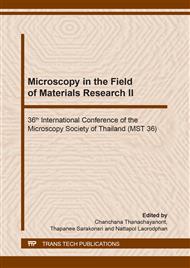[1]
P. Suttiarporn, P. Sookwong, S. Mahatheeranont, Fractionation and Identification of Antioxidant Compounds from Bran of Thai Black Rice cv. Riceberry, International Journal of Chemical Engineering and Applications 7(2) (2016) 109-114.
DOI: 10.7763/ijcea.2016.v7.552
Google Scholar
[2]
L. Cui, Z.L. Pan, T.L. Yue, G.G. Atungulu, J. Berrios, Effect of Ultrasonic Treatment of Brown Rice at Different Temperatures on Cooking Properties and Quality, Cereal Chem 87(5) (2010) 403-408.
DOI: 10.1094/cchem-02-10-0034
Google Scholar
[3]
M. Das, R. Banerjee, S. Bal, Evaluation of Physicochemical Properties of Enzyme Treated Brown Rice (Part B), LWT - Food Science and Technology 41(10) (2008) 2092-2096.
DOI: 10.1016/j.lwt.2007.11.018
Google Scholar
[4]
T.U. Tran, K. Suzuki, H. Okadome, S. Homma, K. Ohtsubo, Analysis of Different the Tastes of Brown Rice and Milled Rice with Milling Yields using a Taste Sensing System, Food Chemistry 88(4) (2004) 557-566.
DOI: 10.1016/j.foodchem.2004.02.007
Google Scholar
[5]
S.K. Pankaj, Z. Wan, K.M. Keener, Effects of Cold Plasma on Food Quality: A Review, Foods 7(1) (2018).
DOI: 10.3390/foods7010004
Google Scholar
[6]
P. Bourke, D. Ziuzina, D. Boehm, P.J. Cullen, K. Keener, The Potential of Cold Plasma for Safe and Sustainable Food Production, Trends Biotechnol 36(6) (2018) 615-626.
DOI: 10.1016/j.tibtech.2017.11.001
Google Scholar
[7]
H.H. Chen, Y.K. Chen, H.C. Chang, Evaluation of Physicochemical Properties of Plasma Treated Brown Rice, Food Chemistry 135(1) (2012) 74-79.
DOI: 10.1016/j.foodchem.2012.04.092
Google Scholar
[8]
K.H. Lee, H.J. Kim, K.S. Woo, C. Jo, J.K. Kim, S.H. Kim, H.Y. Park, S.K. Oh, W.H. Kim, Evaluation of Cold Plasma Treatments for Improved Microbial and Physicochemical Qualities of Brown Rice, Lwt 73 (2016) 442-447.
DOI: 10.1016/j.lwt.2016.06.055
Google Scholar
[9]
R. Thirumdas, C. Saragapani, M.T. Ajinkya, R.R. Deshmukh, U.S. Annapure, Influence of Low Pressure Cold Plasma on Cooking and Textural Properties of Brown Rice, Innovative Food Science & Emerging Technologies 37 (2016) 53-60.
DOI: 10.1016/j.ifset.2016.08.009
Google Scholar
[10]
O. Kylián, B. Denis, K. Stapelmann, A. Ruiz, H. Rauscher, F. Rossi, Characterization of a Low-pressure Inductively Coupled Plasma Discharge Sustained in Ar/O2/N2 Ternary Mixtures and Evaluation of its Effect on Erosion of Biological Samples, Plasma Processes and Polymers 8(12) (2011) 1137-1145.
DOI: 10.1002/ppap.201100086
Google Scholar
[11]
J.T. Gudmundsson, E.G. Thorsteinsson, Oxygen Discharges Diluted with Argon: Dissociation Processes, Plasma Sources Science and Technology 16(2) (2007) 399-412.
DOI: 10.1088/0963-0252/16/2/025
Google Scholar
[12]
A.W. Zia, Y.Q. Wang, S. Lee, Effect of Physical and Chemical Plasma Etching on Surface Wettability of Carbon Fiber-Reinforced Polymer Composites for Bone Plate Applications, Advances in Polymer Technology 34(1) (2015).
DOI: 10.1002/adv.21480
Google Scholar
[13]
M.H. Lee, C.W. Chung, On the E to H and H to E Transition Mechanisms in Inductively Coupled Plasma, Physics of Plasmas 13(6) (2006).
Google Scholar
[14]
M.A. Razzak, S. Takamura, Y. Uesugi, Transient Behaviors of Radio Frequency Inductive Discharges in Atmospheric Pressure, 47 (2004) 25-28.
Google Scholar
[15]
J.K. Lee, H.C. Lee, C.W. Chung, E–H Mode Transition in Inductively Coupled Plasma using Ar, O2, N2, and Mixture Gas, Current Applied Physics 11(5) (2011) S149-S153.
DOI: 10.1016/j.cap.2011.04.009
Google Scholar
[16]
M.H. Lee, K.H. Lee, D.S. Hyun, C.W. Chung, On the Hysteresis in E to H and H to E Transitions and the Multistep Ionization in Inductively Coupled Plasma, Applied Physics Letters 90(19) (2007).
DOI: 10.1063/1.2734501
Google Scholar
[17]
J. Wangkanai, W. Arworn, S. Dangtip, Study of Inductive Mode in Inductively Coupled Argon Plasma at Low Pressure Using Optical Emission Spectroscopy, The 6th International Graduate Research Conference, Chiang Mai, 2017, pp.90-93.
Google Scholar
[18]
C. Sarangapani, Y. Devi, R. Thirundas, U.S. Annapure, R.R. Deshmukh, Effect of Low-pressure Plasma on Physico-chemical Properties of Parboiled Rice, LWT - Food Science and Technology 63(1) (2015) 452-460.
DOI: 10.1016/j.lwt.2015.03.026
Google Scholar
[19]
T.H. Chung, H. Ra Kang, M. Keun Bae, Optical Emission Diagnostics with Electric Probe Measurements of Inductively Coupled Ar/O2/Ar-O2 Plasmas, Physics of Plasmas 19(11) (2012).
DOI: 10.1063/1.4765357
Google Scholar
[20]
J.B. Boffard, R.O. Jung, C.C. Lin, A.E. Wendt, Optical Emission Measurements of Electron Energy Distributions in Low-pressure Argon Inductively Coupled Plasmas, Plasma Sources Science and Technology 19(6) (2010).
DOI: 10.1088/0963-0252/19/6/065001
Google Scholar
[21]
T. Czerwiec, D.B. Graves, Mode Transitions in Low Pressure Rare Gas Cylindrical ICP Discharge Studied by Optical Emission Spectroscopy, Journal of Physics D: Applied Physics 37(20) (2004) 2827-2840.
DOI: 10.1088/0022-3727/37/20/009
Google Scholar
[22]
H.H. Ley, Analytical Methods in Plasma Diagnostic by Optical Emission Spectroscopy: A Tutorial Review, Journal of Science and Technology 6(1) (2014).
Google Scholar
[23]
A. Falahat, A. Ganjovi, M. Taraz, M.N.R. Ravari, A. Shahedi, Optical Characteristics of a RF DBD Plasma Jet in Various Ar/O2 Mixtures, Pramana 90(2) (2018).
DOI: 10.1007/s12043-018-1520-6
Google Scholar
[24]
B.O. Juliano, Rice in human nutrition, Int. Rice Res. Inst.(1993).
Google Scholar
[25]
C. Sarangapani, R. Yamuna Devi, R. Thirumdas, A.M. Trimukhe, R.R. Deshmukh, U.S. Annapure, Physico-chemical Properties of Low-pressure Plasma Treated Black gram, LWT - Food Science and Technology 79 (2017) 102-110.
DOI: 10.1016/j.lwt.2017.01.017
Google Scholar
[26]
J.A. Juárez-Moreno, L.G. Brito-Argáez, A. Ávila-Ortega, A.I. Oliva, F. Avilés, J.V. Cauich-Rodríguez, Effect of the Type of Plasma on the Polydimethylsiloxane/collagen Composites Adhesive Properties, International Journal of Adhesion and Adhesives 77 (2017) 85-95.
DOI: 10.1016/j.ijadhadh.2017.03.010
Google Scholar
[27]
P. Bizi-Bandoki, S. Benayoun, S. Valette, B. Beaugiraud, E. Audouard, Modifications of Roughness and Wettability Properties of Metals Induced by Femtosecond Laser Treatment, Applied Surface Science 257(12) (2011) 5213-5218.
DOI: 10.1016/j.apsusc.2010.12.089
Google Scholar


